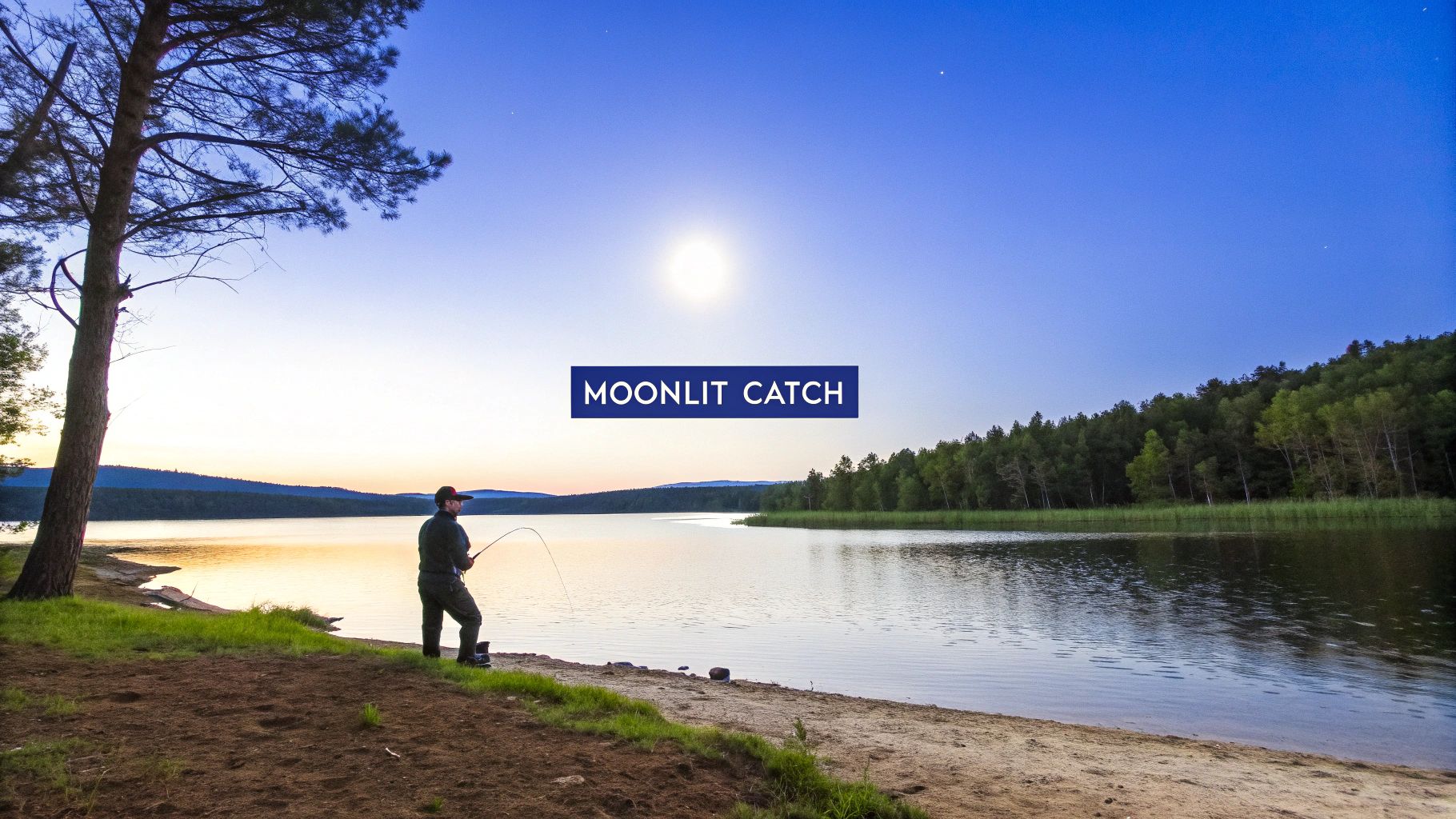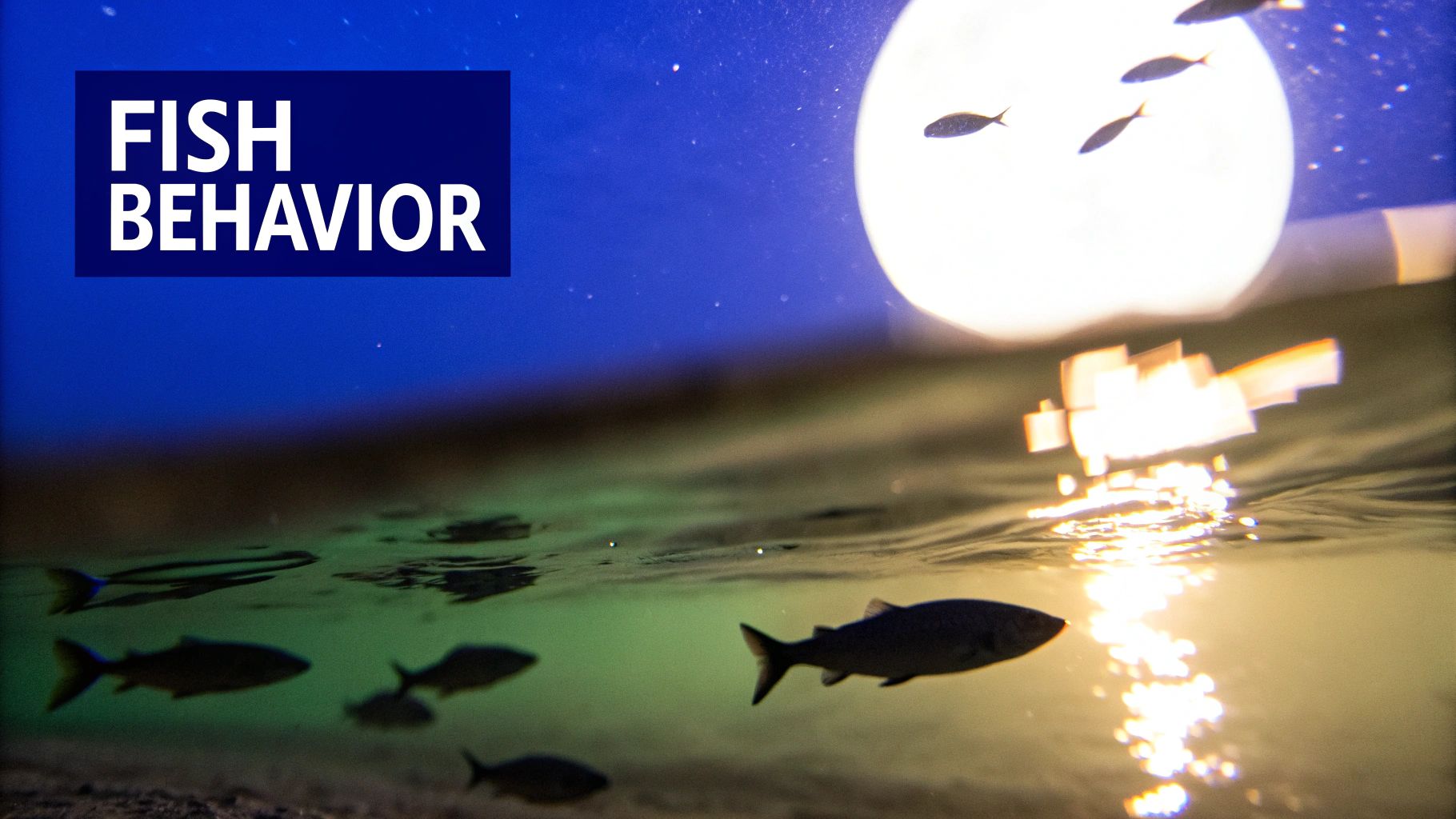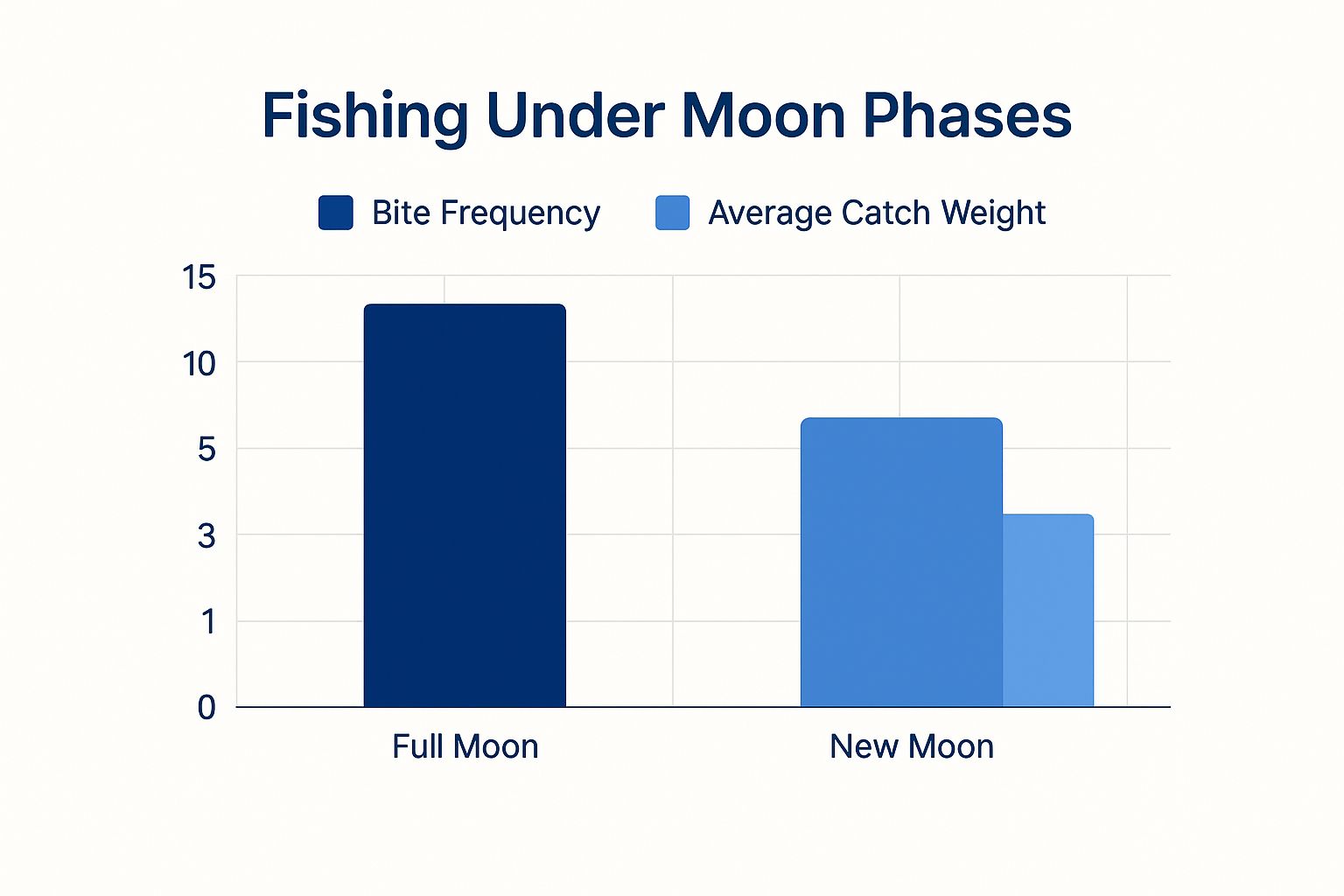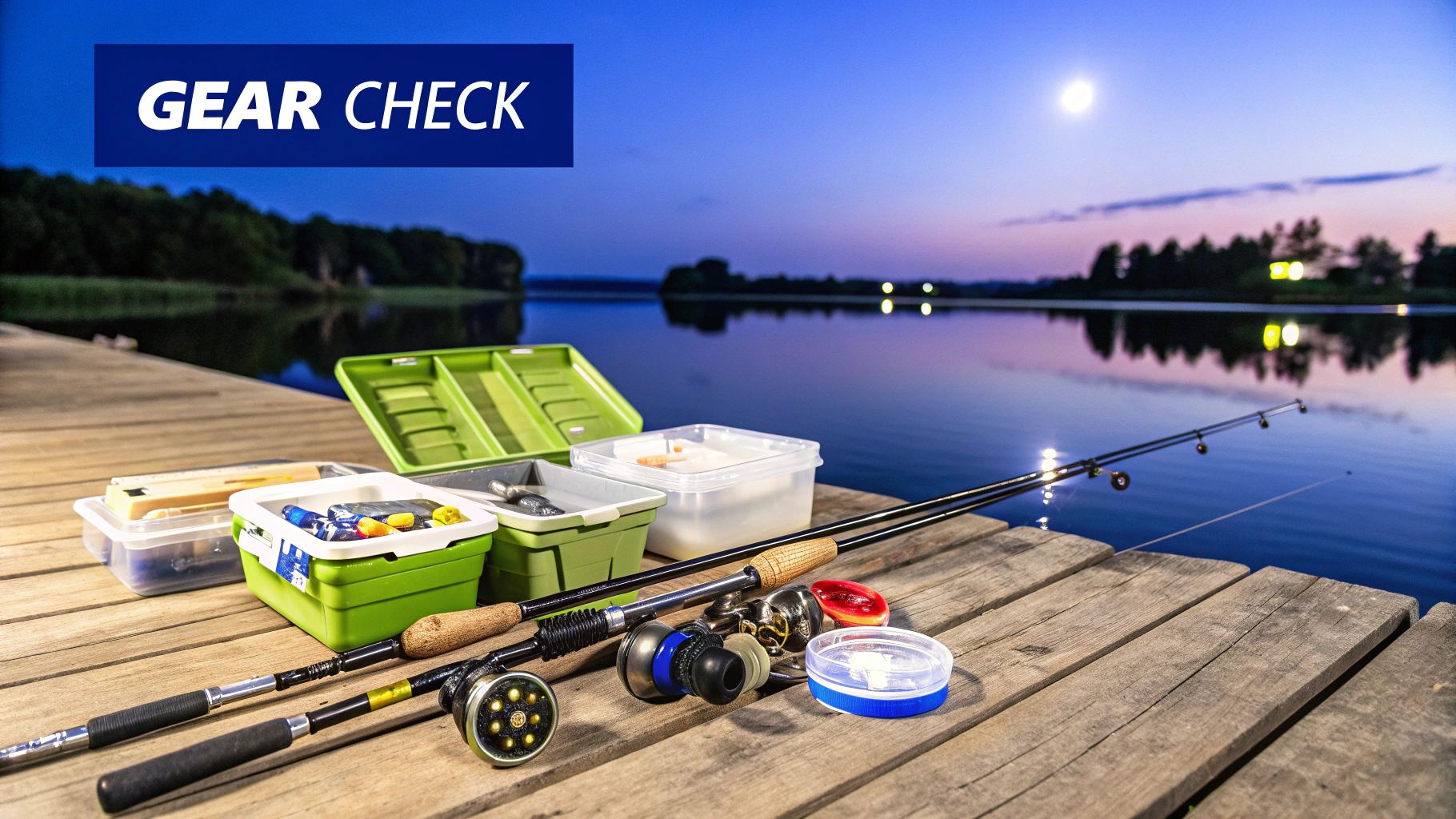Full Moon and Fishing: Secrets from Legendary Anglers
For generations, the best anglers have known a simple truth: the full moon is more than just a light in the sky. It's a dinner bell for the ocean's biggest predators. For sportfishing legends like Ed and Frank Murray, who built their careers on winning high-stakes saltwater tournaments, understanding this rhythm wasn't just an advantage—it was essential. The link between the full moon and fishing is a time-tested strategy for landing trophy fish, a secret passed down through the annals of sportfishing history.
Why Legendary Anglers Fish by the Moon

For sportfishing legends Ed and Frank Murray, winning saltwater tournaments was never just about having the best gear or the fastest boat. It was about reading the ocean’s oldest clock: the moon. This deep understanding of lunar cycles wasn't an old sailor's tale; it was a core piece of their strategy, a tactical advantage that consistently put them on the podium.
The Murray Brothers forged their reputation in the competitive crucible of big-game tournaments, where a single decision could mean the difference between a championship title and going home empty-handed. Over countless hours on the water, they observed a distinct pattern: their most significant victories often coincided with the powerful influence of a full moon. This was no coincidence. It was a calculated approach, honed over decades of experience and built on generations of hard-won angling wisdom.
The Moon as a Master Switch
Think of the full moon as a master switch for the entire marine food web. Its gravitational pull creates stronger tides, setting off a chain reaction beneath the waves. This surge in activity pushes baitfish into predictable patterns, and where the bait goes, the big predators are sure to follow.
The Murrays understood this dynamic better than almost anyone. They knew a full moon created the perfect hunting grounds for the aggressive gamefish they relentlessly pursued in tournaments.
This fundamental principle shaped everything they did, from deciding where to drop a line to choosing the right lure for the job. Their experience is a cornerstone in the history of sportfishing, proving how ancient knowledge can still lead to modern success.
For master anglers, the moon is not just a celestial body but a strategic tool. It dictates the timing of tides, the behavior of bait, and the feeding patterns of predators, offering a predictable rhythm in an otherwise unpredictable ocean.
By lining up their tournament efforts with these lunar rhythms, Ed and Frank could anticipate when and where fish would be most active. This section will break down the foundational wisdom that turned their understanding of the full moon into a legendary advantage on the water.
How the Full Moon Fires Up the Ocean Food Chain

When you hear sportfishing legends like the Murray Brothers recount stories of epic tournament wins during a full moon, they’re not just spinning tales. There’s serious, predictable ocean science behind their success. When the full moon aligns perfectly with the sun and Earth, their combined gravitational pull gets a massive boost. This creates the strongest tides of the month—known as spring tides—which essentially act like a giant blender for the entire marine ecosystem.
Think of the ocean floor as a pantry where nutrients have settled. The powerful currents of a full moon stir everything up, churning that nutrient-rich sediment toward the surface. This sudden feast attracts huge schools of plankton, and right on their tails are legions of baitfish. It’s a concentrated, predictable buffet, and you can bet that wherever the baitfish are swarming, the big predatory sportfish won't be far behind.
This chain reaction turns the ocean into a supercharged hunting ground. It’s the simplest explanation for why full moon and fishing are so deeply connected.
Moonlight: Nature's Spotlight
It's not just about the tides. The full moon gives predators another massive advantage: bright, natural light. After sunset, a brilliant full moon can illuminate the ocean's surface, turning a pitch-black expanse into a well-lit stage. For any predator that hunts by sight, these are prime conditions for a nighttime feast.
Nocturnal hunters, in particular, hit their stride. The moonlight lets them easily spot the silhouettes of baitfish swimming above, making ambushes far more effective. For many of the gamefish pursued in saltwater sportfishing tournaments, this extra visibility is a major trigger for aggressive feeding.
The Rhythms of Spawning and Feeding
This explosion of activity isn't just about finding an easy meal; it’s tied to the fundamental biological clocks of marine life. That potent combination of strong tides and bright moonlight is a known trigger for spawning events in many fish species. This is why generations of anglers have noticed a direct link between the moon phases and their catch rates, with some of the most memorable, record-breaking fish being pulled from the water during a full moon.
It just makes sense. The extra light helps nocturnal hunters like sharks and various bottom-feeders, while species like snapper become more active and gather in huge numbers to spawn. You can dive deeper into these lunar connections over at FishingStatus.com.
The full moon doesn't just change the tides; it changes the rules of the game. It creates a temporary, high-energy environment where the food chain is supercharged, predators have a distinct advantage, and the chances of a legendary catch increase dramatically.
In the end, the science just confirms what seasoned fishermen have known all along. The full moon kicks off a powerful and predictable cascade of events, starting with a gravitational tug-of-war and ending in an all-out feeding frenzy. It creates the perfect storm for an unforgettable fishing trip.
Finding Your Peak Lunar Fishing Window
Most fishermen circle the one night of the full moon on their calendars and expect the fish to just jump in the boat. But as saltwater legends Ed and Frank Murray learned over decades on the tournament circuit, the real action isn't limited to that single night.
The true magic happens in the days leading up to and immediately following the full moon. This is when the gravitational pull is strongest, creating powerful tidal movements. Think of this surge like a giant conveyor belt, pushing baitfish out of their hiding spots and concentrating them along current rips and structure. It was in these zones that the Murrays focused their efforts, turning a simple waiting game into a calculated hunt for feeding predators.
The Science of the Solunar Window
This angler's intuition is backed by solid science. While the night of the full moon can be great, studies on fish catches consistently show the bite actually peaks on specific days around the main event. It's the intense currents during this broader window that trigger the most aggressive and predictable feeding frenzies.
For example, research analyzing multiple river sampling sites found that the biggest hauls of finfish and prawns typically happened on the third day after the full moon and, interestingly, the third day after the new moon. This confirms what guys like the Murrays knew from experience: timing your trip around these peak days can make all the difference. You can dive into the data yourself by reading the full study about these optimal fishing windows.
The peak fishing window isn't a single point in time; it's a phase of intense activity. Think of it less like flipping a switch and more like an incoming tide—it builds, peaks, and then recedes. The key is being on the water when the current is strongest.
By understanding this, the Murray Brothers could glance at a lunar calendar and pinpoint the exact days their odds of a tournament win were highest. They knew precisely when the ocean's dinner bell would be ringing the loudest. Of course, being ready for that moment meant having the best saltwater fishing gear on board.
Optimal Full Moon Fishing Windows
To make this easier to digest, here's a quick breakdown of the most productive times to be on the water around a full moon.
| Lunar Window | Tidal Activity | Expected Fish Behavior | Murray Brothers' Tip |
|---|---|---|---|
| 3 Days Before Full Moon | Strong incoming tides | Baitfish schooling up; predators begin staging. | Focus on structure where bait is gathering. |
| The Full Moon Night | Peak high and low tides | Aggressive feeding, especially at night. | Topwater lures can be deadly in the moonlight. |
| 3 Days After Full Moon | Strong outgoing tides | Disoriented baitfish are easy targets. | Fish the "backside" of current breaks. |
These periods represent the sweet spot where tidal forces and fish behavior align, giving you the best shot at a memorable day.
Bite Frequency and Catch Weight
This isn't just theory—the numbers back it up. Take a look at this breakdown of bite frequency and the average size of fish caught during full and new moon phases.

As you can see, the data is pretty clear. While you can catch fish during both phases, the full moon period tends to produce a higher number of bites per hour and a bigger average catch weight. This is exactly why so many legendary anglers prioritize fishing around the full moon when they're looking for both consistent action and true trophy-sized fish.
Proven Tactics for Full Moon Sportfishing
Knowing when to fish during a full moon is only half the battle. If you really want to make the most of those peak windows, you have to adapt your techniques. For saltwater sportfishing legends Ed and Frank Murray, this meant fine-tuning every single detail—from the lure on the end of the line to how it was presented—based on the unique conditions the bright moon and strong currents create.
Their whole tournament-winning playbook was built on one simple principle: think like a predator. Under a full moon, that bright sky creates a backdrop that completely changes how fish see their prey from below. The Murrays understood that a lure's silhouette becomes far more important than its color.
This insight led them to favor dark topwater lures. Against the illuminated surface, these lures create a perfect, high-contrast profile that's an irresistible target for aggressive feeders looking up. This simple adjustment often made all the difference, especially in competitive tournaments where every single bite counts. It’s a classic example of how the best anglers use their environment to their advantage.
Adapting Your Approach for Key Species
The Murray Brothers never used a one-size-fits-all strategy. Their tactics were dialed in for the specific species they were targeting, accounting for how each predator uses the full moon to hunt. This is the kind of detail that separated them from the competition and filled their logbooks with wins.
Here are a few battle-tested strategies straight from their playbook:
- Targeting Tarpon in the Shallows: When the moon is full, tarpon often push into shallow flats and channels to ambush prey. The Murrays would position their boat to cast along shadow lines created by mangroves or bridges. They knew these "Silver Kings" would use the darkness for cover before exploding on anything that swam through the moonlit water.
- Finding Marlin Along Current Rips: The powerful tides of a full moon create distinct current rips offshore. These rips are like conveyor belts for baitfish, and the Murrays knew that marlin would patrol these edges. They focused on trolling lures parallel to these visible current lines, presenting an easy meal to a cruising predator. This is the kind of tactic that requires a real understanding of the ocean, a crucial skill for anglers wanting to start fishing for blue marlin successfully.
The most successful anglers don’t just fish during the full moon; they adjust their entire strategy to it. They change their location, lure choice, and presentation to match the aggressive, light-driven feeding behaviors that this unique lunar phase triggers.
Gear Adjustments for Lunar Conditions
Beyond just lures and locations, the Murrays also made critical gear adjustments to handle the challenges of full moon fishing. For one, the bright light and often clearer water can make fish more line-shy. At the same time, those stronger currents can easily pull your bait right out of the strike zone.
To deal with this, they often downsized their leader material, switching to a lighter fluorocarbon that was practically invisible underwater. They also made sure to carry heavier weights or sinkers than usual. This was the only way to guarantee their baits could get down to the right depth despite the ripping tides.
These might seem like small changes, but they are incredibly strategic. They ensured their presentation was always perfect, allowing them to capitalize on the aggressive feeding that makes full moon and fishing such a legendary combination.
Why Lunar Cycles Matter on a Global Scale

The age-old wisdom of fishing by the moon isn't just folklore passed down by recreational anglers. Legends like Ed and Frank Murray proved its power in saltwater tournaments, but this natural rhythm governs fishing on a massive, global scale, from local charter guides to the largest commercial fleets.
It's a universal principle that quietly shapes entire ecosystems. This proves the connection between the full moon and fishing isn't just a handy tip—it's a fundamental law of the ocean. When you look at the bigger picture, you see the same lunar forces that trigger a feeding frenzy for a single marlin also dictate the movements of vast schools of fish targeted by huge commercial operations.
This shared knowledge connects a weekend angler casting a line off a pier to a commercial captain halfway across the world. They're all following the same ancient clock.
From Tournament Trophies to Global Fisheries
The techniques the Murray Brothers used to dominate high-stakes tournaments are really a small-scale version of a much bigger reality. Their strategy of timing trips around peak lunar tides is the same one used by commercial fleets that need to squeeze every drop of efficiency out of their operations. For them, fuel and time are money, so predictable patterns are everything.
And this isn't just gut feeling anymore. Modern fisheries science is finally catching up and validating what anglers have known for generations. Scientists and fisheries managers now use lunar data as a key tool to understand and protect fish stocks.
By stacking catch data up against moon phases, they can more accurately predict population shifts, pinpoint spawning periods, and set sustainable catch limits. This scientific backing just confirms it: the moon is one of the most powerful and reliable indicators of what's happening under the water.
The moon's influence is the great equalizer in fishing. It’s the common thread that links the gut feeling of a seasoned angler with the data-driven models of modern fisheries management, cementing its role as a critical piece of the puzzle.
Lunar Rhythms in the South China Sea
You can see this global impact crystal clear in major fishing regions. Take the South China Sea, one of the world's most vital fisheries. Fishing activity there shows distinct, undeniable patterns tied directly to the lunar cycle.
Researchers have observed how fishing efforts ramp up and die down in perfect alignment with the moon phases to take advantage of predictable fish behavior. By analyzing what’s happening during specific lunar nights, scientists can better separate ecological trends from the effects of human fishing pressure. This shows just how important it is to fold lunar data into large-scale fisheries management.
You can learn more about how lunar timing clarifies global fishing trends and how this approach is now essential for sustaining major fish markets worldwide. It’s definitive proof of the moon’s enduring and powerful pull.
Your Top Full Moon Fishing Questions, Answered
Alright, so we've covered the science and the strategies from legends like Ed and Frank Murray. But I know there are still some lingering questions that pop up when you're actually getting ready to hit the water. Let's tackle the most common ones head-on so you can feel completely prepared for your next full moon adventure.
My goal here is to give you clear, practical answers that you can put to use right away.
Is the Night of the Full Moon the Best Time to Fish?
Not necessarily, and this is a classic misconception. While that one night can be good, the real magic often happens in the days surrounding it. The Murray Brothers consistently found their best results in the two to three days before and after the full moon.
Why? It all comes down to the tides. This is when the currents are running their hardest, pulling baitfish from their hiding spots and basically ringing a dinner bell for predators. Think of the full moon as a window of opportunity, not just a single night. Focus your trips on these peak tidal flow days, and you'll hit those intense, predictable feeding frenzies. In fact, some studies even show fish catches hitting their absolute peak on the third day after a full moon.
The secret isn't fishing on the exact night of the full moon. It's targeting the days with the strongest tidal currents that surround it. That's where you'll find the most aggressive action.
Does a Full Moon Affect Freshwater and Saltwater Fishing Differently?
It sure does. The impact is way more dramatic in saltwater, simply because the moon's gravitational pull is what drives the tides. These powerful currents are the main event, kicking the entire coastal food chain into high gear. In freshwater lakes and rivers, that tidal effect is pretty much zero.
But that doesn't mean the full moon is a non-factor for freshwater anglers. The bright moonlight itself changes the game. Bass, for instance, will use the extra light to hunt aggressively all night long. Fish that are typically more light-sensitive, like walleye, might push into shallower areas to feed where they normally wouldn't. So, while the "why" is different—strong tides versus bright light—the full moon still creates unique and productive fishing scenarios in both environments.
Should I Change My Gear for Full Moon Fishing?
Absolutely. A good angler always adjusts to the conditions. That bright moonlight can also mean clearer water, making fish a lot more line-shy than usual. This is the perfect time to switch to a lighter fluorocarbon leader to avoid spooking them.
Lure selection is just as important. The Murray Brothers swore by topwater plugs and lures that cast a distinct silhouette against the moonlit surface. You might be surprised to hear that dark-colored lures are often the best choice—they create a stark, black profile that fish looking up from below can't miss. And don't forget about those stronger currents; you may need heavier weights or sinkers to keep your bait down in the strike zone where the fish are holding.
For battle-tested gear that stands up to the most demanding conditions, explore the full collection from Murray Brothers Palm Beach. Our apparel and equipment are designed with a deep respect for fishing tradition and are built to help you make the most of every trip. Find your legendary gear at Murray Brothers Retro.


Dejar un comentario